
Editor’s note: Nanzi Muro, an interdisciplinary fronteriza artivist, is pursuing her Master of Fine Arts degree at San Diego State University, expected to be completed in May 2025. Recently, she hosted a solo exhibition called “What a Journey: Lleno de Resistencia” at The Front Arte Cultura community art gallery in San Ysidro, CA, held from February 1 to 8.
In her introductory text for the exhibition, Nanzi wrote, “This solo exhibition advocates for change and justice in education, particularly addressing the injustices faced by women and BIPOC (Black, Indigenous, People of Color) students in higher education. Through photography, ceramics, illustration, digital drawing, and installation, the artist highlights institutional retaliation and the challenges encountered by marginalized students in art institutions. By transforming personal struggles into art, the exhibition serves as a form of artivism, ensuring that others do not endure similar hardships. This exhibition is also a crucial step in completing the artist’s Master of Fine Arts program. It takes place in a space that amplifies the voices of students of color who have faced similar struggles. The recurring presence of red throughout the exhibition symbolizes both danger and resilience, as well as love and healing.”
The People’s Tribune recently interviewed Nanzi (who also works with our sister bilingual publication, El Tribuno del Pueblo). Below are excerpts from that interview, and some photos of pieces in her exhibition.
People’s Tribune: Tell us about the project that you did for the exhibition and why you did it.
For me to get my diploma, this is a requirement. We have to do a solo show, an exhibition that is open to the real world and outside viewers beyond the educational setting. While this type of exhibition is usually held at the university, I organized mine outside because I didn’t receive adequate support from the institution. I have moral support from some professors, but it’s not provided when it comes to equipment, materials, and working in other mediums—I work in more than one medium. I asked for support for basic necessities; I was not asking the school for a million dollars’ worth of equipment. I just needed to use the equipment they already have. But there were layers of discussions and back and forth. They created a toxic environment, not just for me but also for other students. However, I was the only student who really spoke up and raised my voice and concerns.
My work primarily focuses on borders, specifically the physical border between Mexico and the United States and migration. However, this time, I applied my skills to discuss my experiences in higher education and the system. Education is not evolving; it presents numerous struggles for students of color like myself, you know what I mean? And it’s not just for students of color; other students face challenges too. The system teaches students only to obey and prepares them for forced work rather than cultivating leaders within the community.
And, you know, I received comments like, “Be quiet. Don’t talk about this because we don’t want things to escalate.” A professor, someone with very light skin and green eyes, said to me, “I’m an immigrant, and English is my second language, too,” even though I never complained about her status or whether English was her second language. I was addressing her behavior in the classroom. Also, comments like, “I do not get paid to do independent study with you.” These are just a few remarks among all the unprofessional comments I’ve received this past year. They create policies during these discussions to deny me access when the school claims to be interdisciplinary. What I notice is that it’s not about the students; it’s about the faculty.
I can see the issue here. They are artists too, so they just want to create art as well because they are artists, and I understand that part. However, they are there to provide a service; they’re there to work. There was access for faculty, but no access for students. If you notice the size of my installation in the middle of the exhibit, it matches the size of her [the faculty member’s] private studio. The school and all its spaces are designed for students. It’s part of the California State University system; it’s a public school, and 60% of the funding comes from taxpayers. The other 40% comes from grants or from funds the students bring to the school. These places are designed for students, not faculty. The more I examined it, the more I found that our program allocates more resources to faculty than to students.
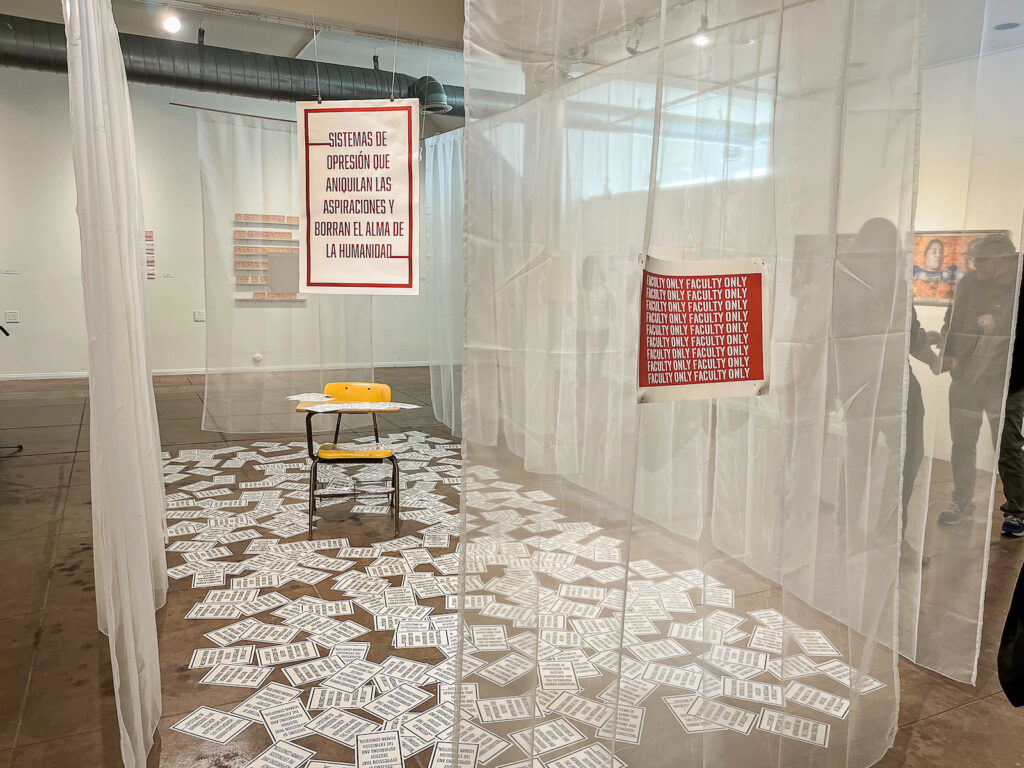
Nanzi Muro, Solo Faculty, 2025. Multimedia installation, 10 ft. x 20 ft. Solo Faculty was inspired by my being denied access to the ceramics facilities in the middle of my program, despite clearly stating in my application’s Statement of Purpose my intention to focus on improving my ceramic skills during my three years in this department. In all my inquiries and multiple emails prior to applying for the program, I asked numerous questions. However, they never indicated that I was required to possess advanced graduate skills in ceramics to join this program and enhance any medium of my choice work. These are the exact words from the School of Art and Design Director rejecting my request to switch from a Graphic Design to a Ceramics emphasis in an email dated Wed., Aug. 16, 2023: “You do not have the necessary experience and medium maturity to pursue graduate-level study in ceramics at this time.” Photo/Bob Lee
PT: And so you had to go outside the university to get the materials you needed and the place to work?
To be able to create all the artwork for this exhibit, I applied for grants and obtained loans. I worked with non-profits that assisted me with extra funds. I did almost everything at home. I live in a tiny studio, and managed to do everything in my small space. For the ceramic pieces, I visited a ceramic studio here in San Diego and used their firing services. They charged me $375 for a 12 x 12 square foot kiln, which is $375 I wasted when I could have done it at school with the tuition I paid.
Supposedly, this was because I didn’t take classes, but I was enrolled in ceramics classes from my first semesters at this school. I was working there as a tech. However, they only want to cover lies with more lies. A good example is Trump right now; he keeps saying this and that, and we know those are lies. Their facts are not checked. It’s the same with the system at the school. Unfortunately, this isn’t the only school I believe is going through this. I understand that the budget keeps getting cut, but that’s no excuse to be disrespectful and unprofessional with their students.
I did everything I could to raise my concerns, and all I received were comments like, “I don’t usually deal with students,” from an administrator in the art department in the College of Professional Studies and Fine Arts. I find myself asking questions like, what is your position? You work at a university; you need to interact with students. You need to talk to students. It was truly awful—pretty much the definition of discrimination: retaliation, cold shoulders, silence, you know, no support. I learned not only the meaning and definition but also what it feels like and the implications of those words, because that happened to me. My goal is to genuinely open the floor for conversations because I’m not the only student of color who has gone through this. My goal is to prevent this from happening to any other students.
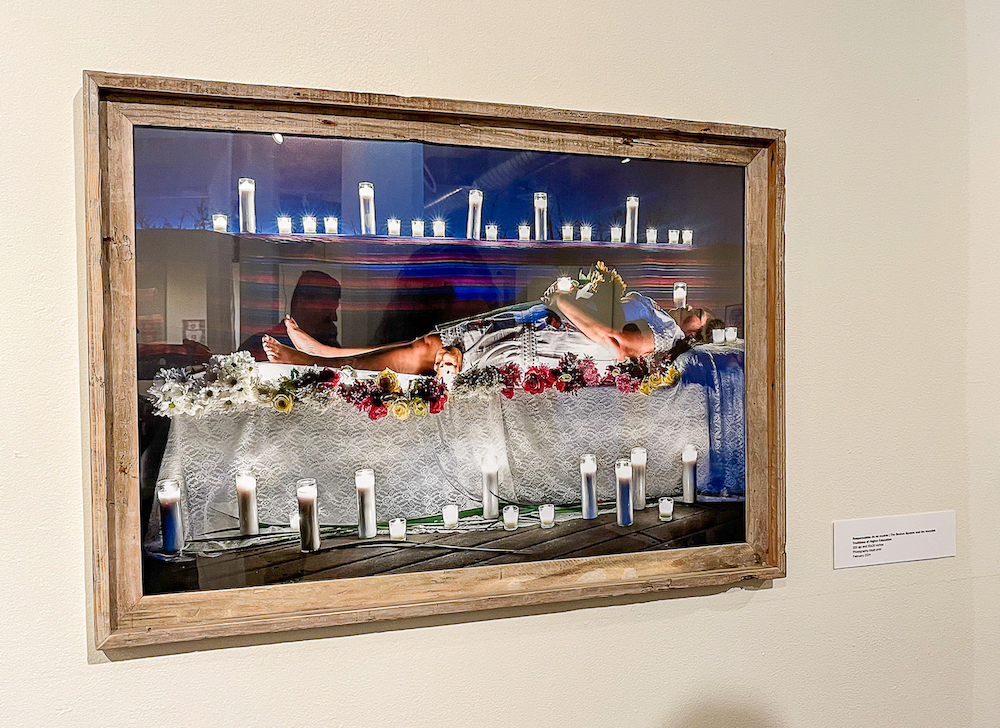
Nanzi Muro, Responsables de mi Muerte: The Broken System and the Invisible Traditions of Higher Education, 2024. Photography, 20 in. x 30 in. This photograph depicts me lying in a posture resembling death. The university has crushed my dream of being a successful student, and in a way, it has also killed my spirit as a student. I decided to photograph myself lying down with flowers under my body with multiple candles around me, illuminating the setting at nighttime. I am wearing a white dress, which symbolizes hope and the possibility of rebirth. Photo/Bob Lee
Let’s look at the history. We have numerous examples of how this has happened to many other people in the past. One example is the Lemon Grove School Incident in San Diego in 1931. This highlights how the government of Mexico came to help the Mexican community when they were not providing quality education to the students. Additionally, bell hooks is another scholar worth considering, along with Gloria Anzaldúa, Víctor Villaseñor, John Carlos, Tommie Smith, and before them, César Chávez and Dr. Ernesto Galarza. He is one of the key figures thanks to whom we have bilingual education in California. All these individuals fought for students like me to have a future and an education. Now, let’s talk about MEChA (Movimiento Estudiantil Chicano de Aztlán), which planted the seeds of activism in me at a young age. I am grateful to all these people for their long struggle to clear the path for many of us.
Everyone before me came and truly helped shape my path. Now it’s my turn, and I don’t just want to raise concerns about the school; I want to discuss how we can create change. I believe that change needs to start from the outside and work its way in because I’ve already tried making changes from within the system, and nothing has happened.
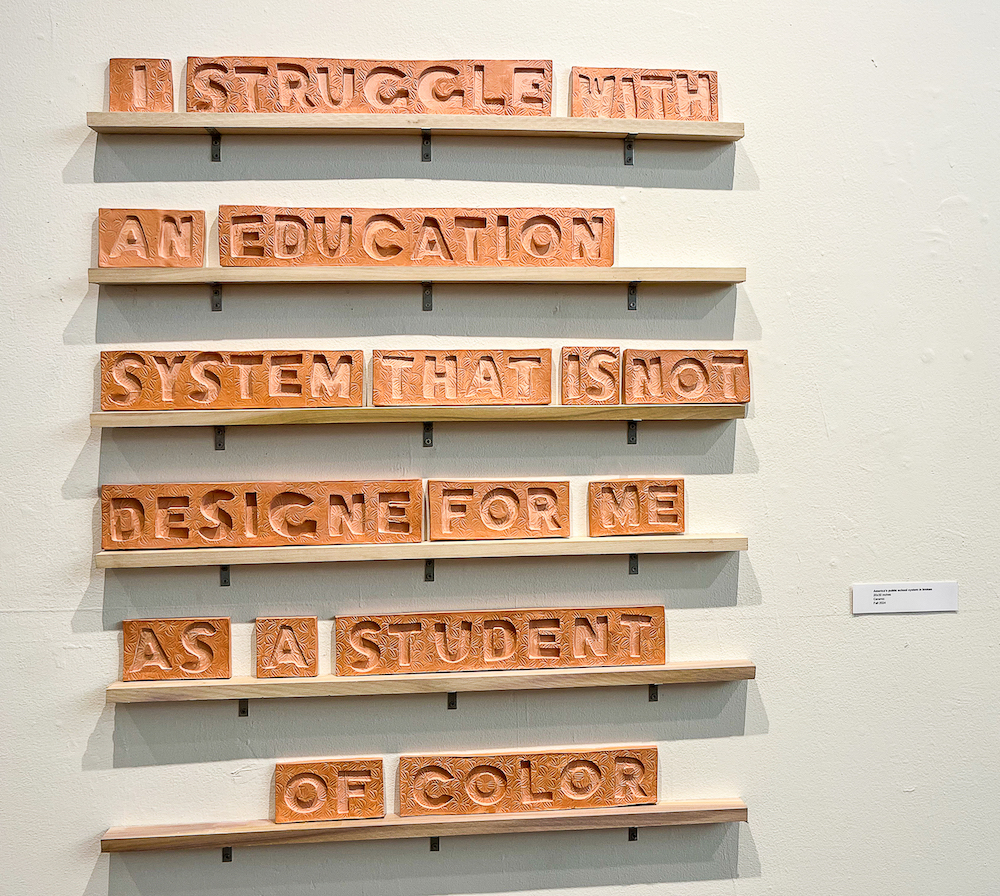
Nanzi Muro, America’s Public School System Is Broken, 2025. Ceramic, 3 ft. x 4 ft. This piece is crafted from slab clay to form flat pieces with letters that convey the following message: “I struggle with an education system that is not designed for me as a student of color.” This piece features six lines of variously sized brownish terra sigillata tiles, creating an earthy atmosphere. Each tile forms a word, with every line containing two to three words. Each line measures three feet wide and four inches high, and the entire display is mounted on wooden shelves. This work highlights my experiences as a brown woman and reflects the feelings of many students who share similar sentiments yet rarely voice them due to fear of retaliation. Some individuals at the university attempted to silence me, instilling fear and denying opportunities. Despite these challenges, I have made significant progress, thanks to those who helped me reaffirm my courage, bravery, and willingness to stand up for myself. Photo/Bob Lee
PT: What were you trying to do that they weren’t giving you support for?
I am interdisciplinary and want to focus on and work in many mediums, not just one. The most shocking part of all this is that one student from a Chinese background, who was a ceramics major, left the program two months after starting due to the school’s behavior and specifically the behavior of this professor. The faculty they hire is also a concern. Again, what we were asking for is minimal, yet the school is not prepared to accept students. They lack the necessary resources and equipment. They claim to be interdisciplinary and encourage students to work with mixed media, but that’s simply not true. That was the main issue. The problem is that I asked for an entire semester if I would have access the following semester because I needed to know. Instead of being honest with me, they just went back and forth with lies, creating policies to deny me and giving me the cold shoulder, even to the point where there were comments like, “she can sue you” threatening me, and “don’t burn your bridges.” As an activist, someone who genuinely engages with community issues, you don’t say those things to students, especially not to someone like me. They essentially said, don’t talk to other students about this because we don’t want it to escalate. You don’t say those things to students like me. I was prepared for everything, especially not to be silent.
When I came to the program, I wanted to do ceramics. I said, “Hey, I visited your program, and you have an excellent ceramics department. This is what I would like to focus on for the next three years.” I had support during my first year from a lecturer, not a faculty member. Lecturers typically have contracts for a year or a semester. I had the support of this amazing lecturer who truly helped me during that first year. She did everything to nurture my passion, to give me love, and to help me trust the system and her. She created opportunities for me and made my first year in the program beautiful and incredible. This lecturer was underpaid and definitely helped other interdisciplinary students like myself. However, later on, they hired someone else, someone different. This new person was not focused on the students; it was all about herself.
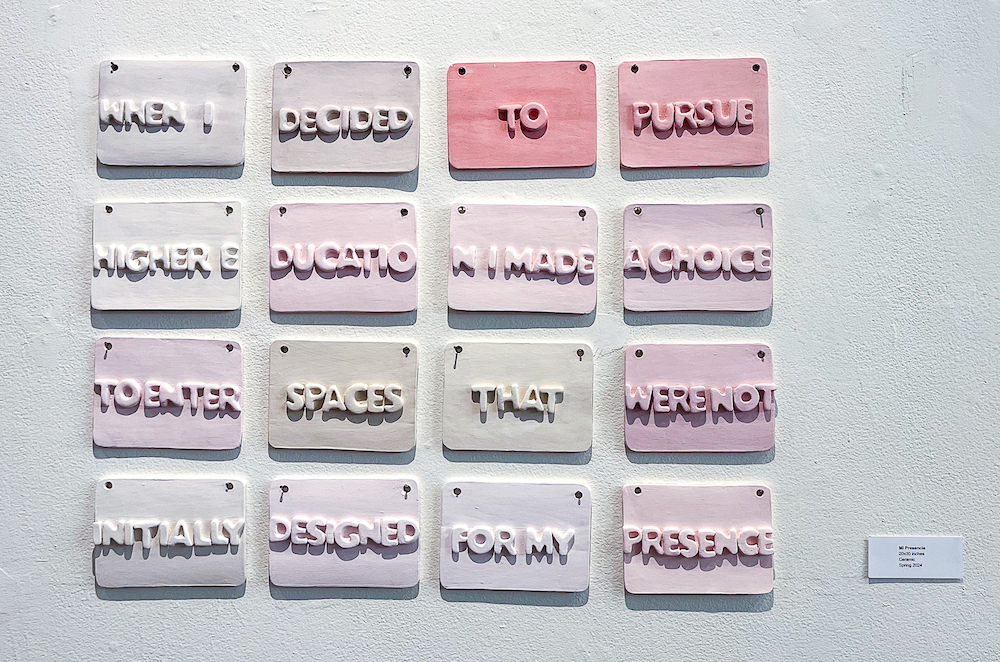
Nanzi Muro, Embracing My Dolor, 2024. Ceramic, 24 in. x 35 in. This piece consists of sixteen rectangular ceramic tiles that feature simple light cream and light pink colors, resembling the skin colors of privileged scholars in art institutions. My decision to glaze the tiles with a light color suggests a lack of diversity in the art department, despite their claim of diversity. The tiles are arranged in four rows, each consisting of four tiles. Each tile has a letter that pops up to form the phrase: “When I decided to pursue higher education, I made a choice to enter spaces that were not initially designed for my presence.” This phrase serves as a reminder that universities are often not welcoming places for students of color, and the inappropriate behavior of staff and faculty reinforces the message of this set of ceramic tiles. The tiles were crafted to look playful and eye-catching from afar, resembling a delightful piece of candy or chewing gum. However, the perspective shifts as viewers get closer and read the messages written on them. They are compelled to confront the harsh realities of exclusion and discrimination within academic institutions, prompting them to reconsider the university’s approach to diversity. Photo/Bob Lee
What I noticed was that this new faculty member was not getting support from the administration. It was her first semester, and she felt oppressed, which in turn led her to oppress her students. The issue arises when problems from the administration affect the students. During the interview process when she was hired, we asked her whether she would support students who are interdisciplinary. As artists, we want to use more than one medium; for example, writers want to incorporate photography. She definitely said yes that she would support interdisciplinary students. In the end, she did not support many interdisciplinary graduate students.
I’m incredibly grateful for my background from previous schools; it’s empowering. So many professors planted that seed in my mind, encouraged me to be myself, and supported me. I’m still in touch with many of them. Thanks to their support, I was able to succeed. With all of this, I think, you know what, I’ve just created my own blueprint. I made it happen. I planned to conduct research outside of school and engage with my community. That’s why I chose to do my exhibition at The Front, a beautiful venue that has not only supported me but also other students and artists, amplifying the voices of the community. They do so much. It’s a wonderful way to close the chapter that marks the end of my higher education journey. I’m so happy that many people who have supported me attended my event. They encouraged me by showing that anything is possible, but we must be persistent. I hope you understand what I mean. The community has given me the courage to keep going.
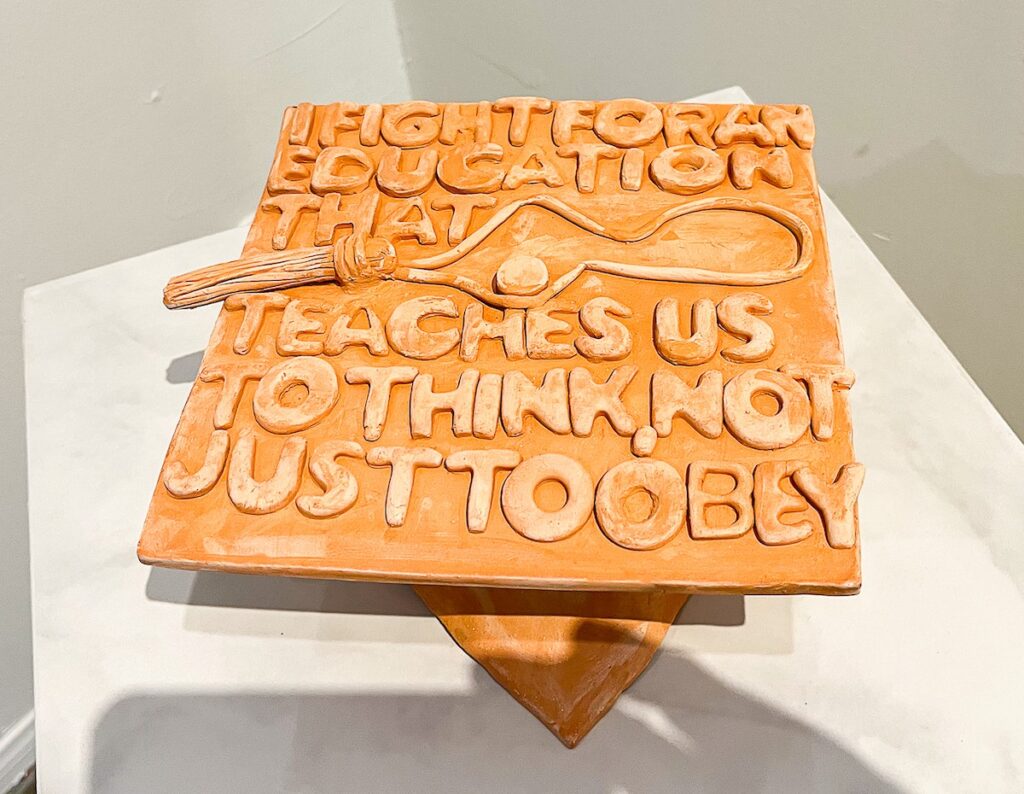
Nanzi Muro, I firmly support an education that fosters dignity, 2025. Ceramic, 15″ x 15″. Photo/Bob Lee
I’m really excited and so happy. All the struggles I went through are repaid with love, support, and so many other good things from my community. I’m continuing to move forward. Let’s not just help me, but also assist the other students who are coming. This is the most important aspect of my work. Yesterday, at my reception, people came to me in tears because they experienced similar situations in their past. They saw my story reflected in theirs because they went through the same thing. Yet, many prefer to stay quiet and endure it. They mentioned it was incredibly brave of me to share my experiences. I believe what we need is to speak more openly. I’m not afraid of what might happen. The school knew I would do this, so they’re not surprised.
PT: And so the exhibition was about exposing what went on?
Yes, it was about exposing and sharing my true experiences. At the end of the day, when I create my art, I use it to amplify the voices of others instead of my own, but this time I focus on myself. If you revisit that piece at the heart of the gallery, it gives a voice to all those students who faced difficulties at this university and didn’t complete the program or earn their degrees. Let’s explore history in other countries, like the 43 students who were killed in Mexico, and the events of 1968 during the Olympics in Mexico, and how many Mexican students were killed by the government [in 1968]. Let’s discuss the Palestinians and the challenges they face, especially the pushback against Palestinian students. In my piece at the center of the exhibit, there’s a sign that reads, “Systems of Oppression that Destroy Aspirations and Extinguish the Human Condition.” It’s a system that impacts so many.
Let’s discuss all the shootings that have occurred in this country. The systems are flawed, and schools are open rather than secure. There are so many layers that can be addressed. The solutions are simple, yet they aren’t willing to put in the effort. In the end, who suffers through all this? That’s my goal; I hope people understand that. I’ve removed myself from the university and am currently pursuing independent studies, as I felt anger in a toxic environment. I found myself frustrated with that anger. I didn’t want to be vengeful; I want to stay true to myself.
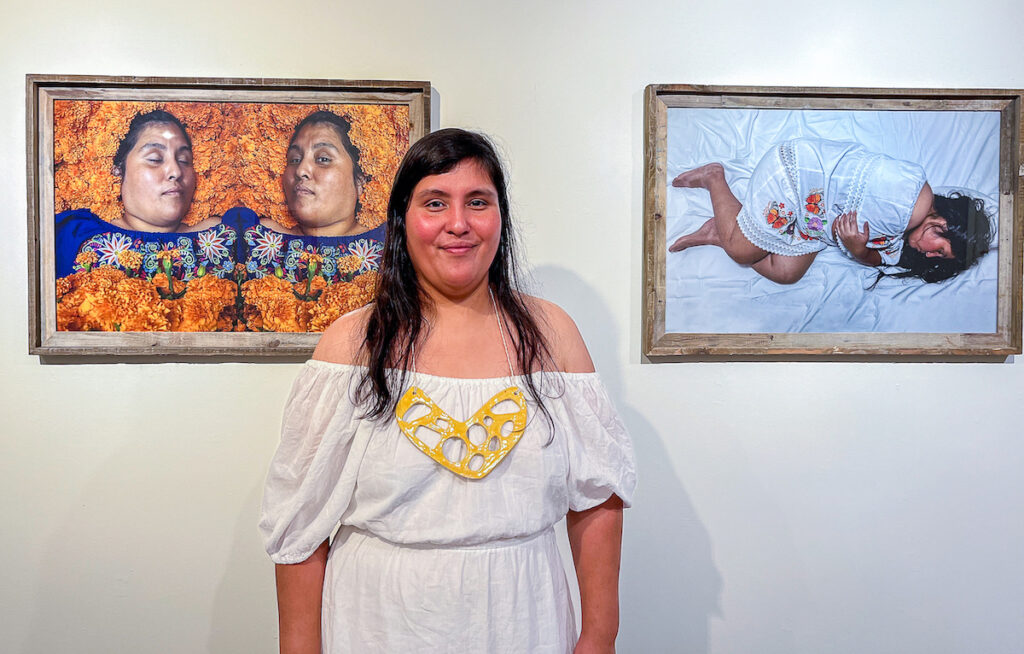
Photo at right: Nanzi Muro, Renacer is Painful, 2024. Photography, 20 in. x 30 in. This photograph shows me lying in bed surrounded by whiteness and hugging myself. I wear the same white dress in both photos. In this image, my body’s position is essential; if you look closely, my eyes are open, but you can see the pain and struggle I feel. The image reflects my rebirth amid pain. I was reborn without crying, only feeling the pain of survival that I have lived my entire life. It is worth mentioning that this is the first time I have made myself the protagonist in my photographic images. In this picture, I express my chronic pain and depression caused by an institution that seems to ignore my concerns. I simply had hoped to enhance my skills in working with ceramic materials and to utilize the ceramic facilities. Unfortunately, I have faced unnecessary comments, unprofessional conduct from faculty and administration, and retaliation, which have obstructed my progress in improving my ceramic skills and having a positive educational experience.
Photo at left: Nanzi Muro, Mi Despertar de la Oscuridad (My Awakening from Darkness), 2024. Photography, 20 in. x 30 in. This photo is similar to the first two images. I am lying down in a royal blue Mexican dress, surrounded by marigolds that reflect a mirror image of myself. However, this image only shows half of myself, from my head to my chest, in contrast to the first two photos. On the left side, my eyes are closed, while on the right side, I am wide awake and aware. As someone dead and revived from darkness, I found myself in a place of sadness, depression, and isolation, where I saw no purpose in continuing my higher education. Nevertheless, my revival was colorful and full of hope, thanks to my community, which helped me emerge from the dark place that the university represented for me.
If we just fight and fight, it keeps us angry and frustrated. However, by being true to ourselves, we find solutions and ways to improve and move forward. I want to stay true to myself instead of holding onto anger, and sometimes, we need to distance ourselves from such places to advance with the community. We don’t want to be poisoned by their negativity. That’s my story with this exhibition; it reflects my experience. That’s why the title of the exhibition is “What a Journey.” You know what I mean? A journey of resistance because there’s resistance and there’s love.
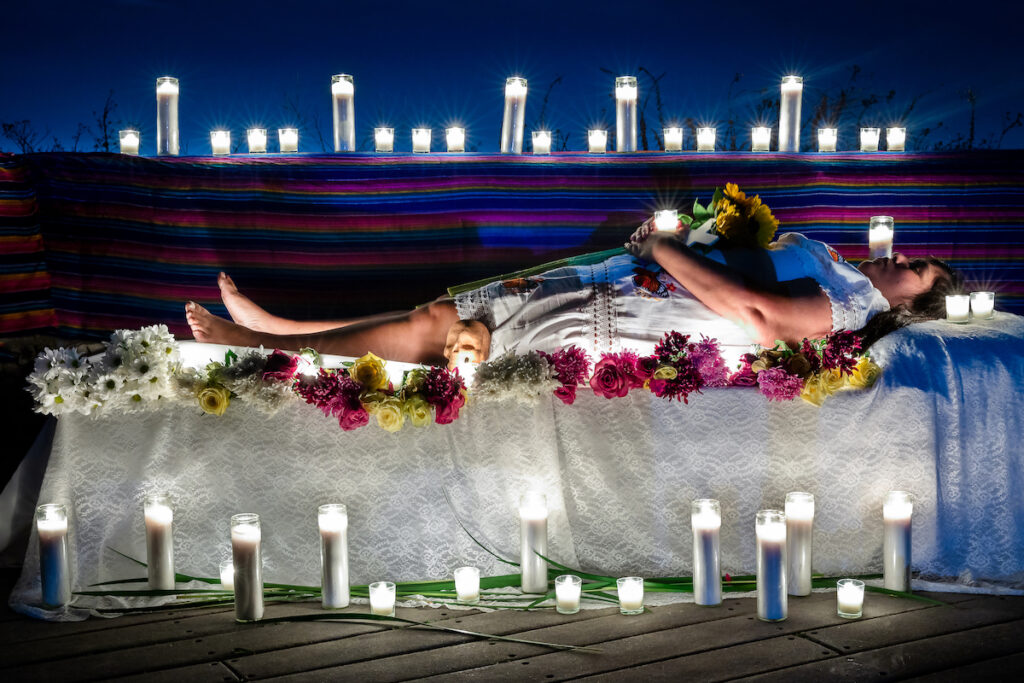
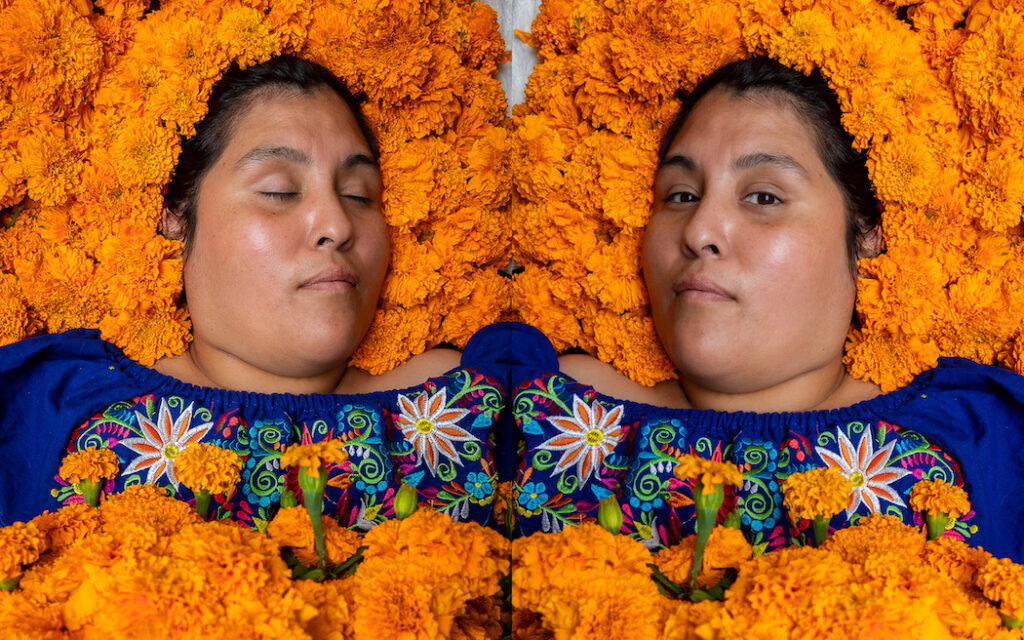
Nanzi Muro is an interdisciplinary Fronteriza artivist based in San Diego, California. Born in Los Angeles, she grew up along the San Diego/Tijuana border, embracing her dual identity as both American and Mexican.
She earned a Bachelor of Fine Arts in Photography with a minor in studio art from San Jose State University and is pursuing a Master of Fine Arts in Artivism. Nanzi has showcased her work internationally, both independently and as part of a collective.
Her recent work emphasizes her border identity and critiques the growing militarization of the U.S.-Mexico border while honoring migrants who have lost their lives in search of a better life. In the past two years, her artistic journey has also involved critiquing institutional failures in higher education, particularly regarding the quality of education for students of color. Nanzi believes education should promote critical thinking over obedience. Her artivism raises awareness and fosters critical thinking about neglected communities.
As an artivist, Nanzi inspires audiences to see that real change starts within. Her artistic mediums—photography, social practices, digital graphics, drawing, ceramics, and installations—address issues faced by marginalized communities. She experiments with materials in series and creates immersive installations that engage participants uniquely.
Bob Lee is a professional journalist, writer and editor, and is co-editor of the People’s Tribune, serving as Managing Editor. He first started writing for and distributing the People’s Tribune in 1980, and joined the editorial board in 1987.

